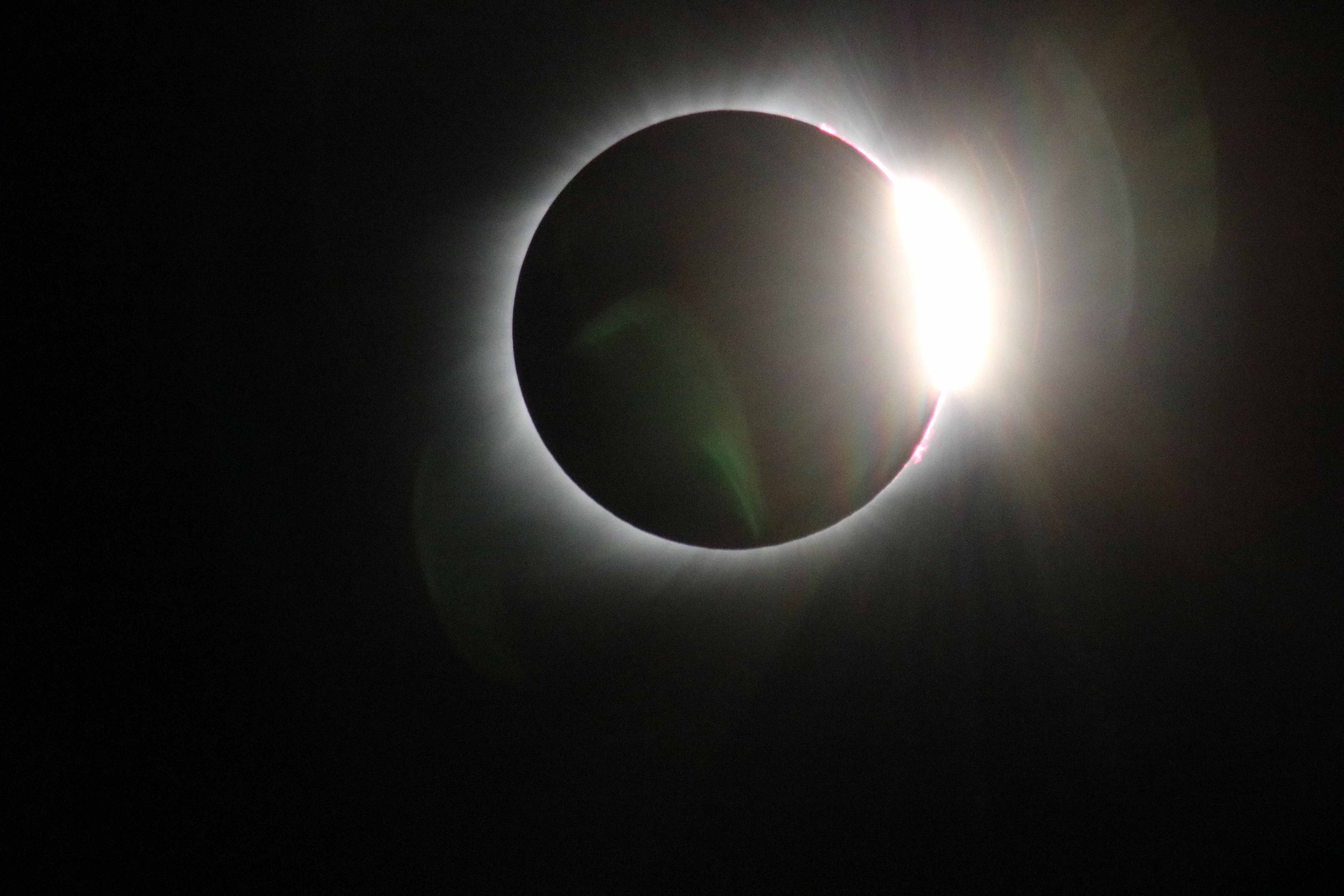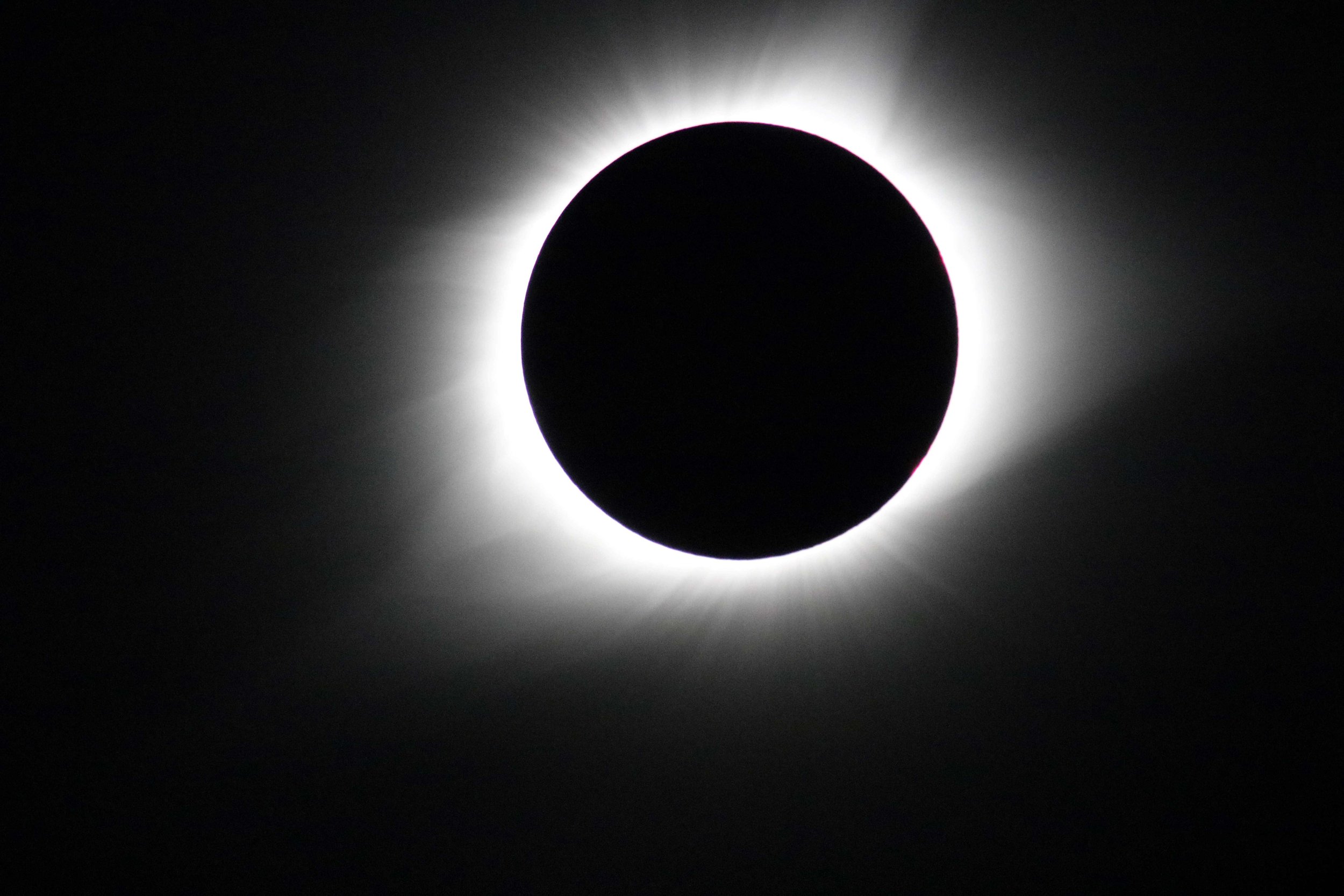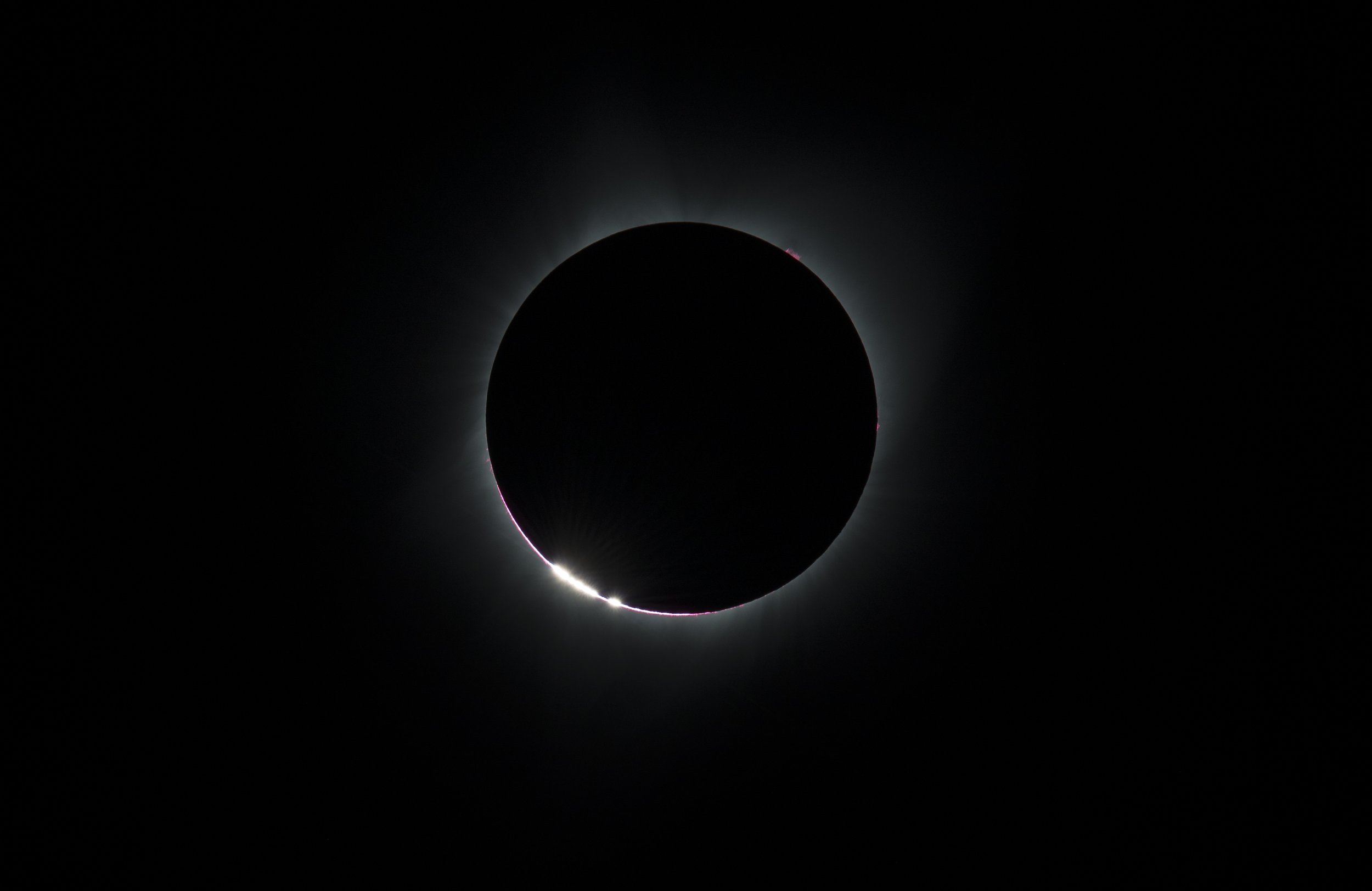UVM eclipse experts share their knowledge, excitement ahead of April 8
March 14, 2024 | By Lauren Milideo | University of Vermont Employees and visitors at NASA's Jet Propulsion Laboratory stopped to watch the Aug. 21, 2017, solar eclipse on Aug. 21, 2017. Credit: NASA/Josh Krohn
University of Vermont experts are gearing up to create an unforgettable experience for students, staff and faculty as a major natural event approaches. On April 8, at 3:26 p.m., as anticipated record crowds fill Burlington, a shadow will sweep across Lake Champlain to cloak the city in middle-of-the-night dark. The 2024 Solar Eclipse is on the horizon.
There are three types of eclipses, with April’s the most dramatic: a total solar eclipse, wherein the moon blocks out the sun’s light, causing darkness to fall in the middle of the day. What observers will see is a fluke of geometry, Senior Physics Lecturer John Perry said. The moon’s orbit is tilted in relation to Earth’s, and the moon typically passes north or south of the sun. And the lunar orbit is elliptical, so the moon’s proximity to Earth varies constantly. But occasionally, Perry said, it all (literally) aligns.
“When the moon and sun are lined up perfectly, and the moon is closer to Earth, you have a total eclipse.” But even then, Perry adds, “the shadow cast by the moon on Earth is actually pretty small, so you've also got to be in just the right place at that moment, to get totality,” when the moon completely blocks the sun.
But, he warns, protective solar glasses are essential even when the sun’s light fades, to prevent eye damage. The full darkness of totality will traverse Mexico, then cross American cities including Austin, Dallas, Little Rock, Indianapolis, Cleveland, and Erie, before moving on to Burlington and finally disappearing off Newfoundland – its whole journey lasting just 90 minutes.
That means things will happen fast. “The sun will be in the southwest during the eclipse here in Burlington,” Perry said. As the moon’s path begins to cross in front of the sun, “the shadow will appear over the lake, and it will get very dark.” The darkness – that famous totality – will last 3 minutes and 15 seconds. An eclipse isn’t just about darkness, though; there’s plenty to look for in those moments of shadow. Perry, for one, has his must-see list ready.



“If it's clear, Mercury should show up pretty well,” Perry muses. “Venus, normally the third brightest, will be the brightest thing in the sky. You’ll see the corona, the outer atmosphere of the sun, which is dramatically shaped due to the sun’s magnetic field. Just before the moon blocks out the whole sun, you'll see this crescent of sunlight coming through the valleys of the moon along its leading edge, creating bright little beads of sunlight, called Baily’s beads. You'll then see one big bead of bright sunlight coming through last – the diamond ring effect.” And then, on this early April afternoon, when Vermont’s summer crops are not yet planted, Perry will look for constellations normally visible over head-high cornfields in Vermont’s August sky.
Eclipses aren’t actually rare, Perry said – they happen about every six months. But not all are total, and with Earth’s surface over 70% water, they typically pass, without much fanfare, over an ocean.
But if this one feels different – well, for Vermonters, it is. “It's passing over us,” Perry said.
‘A once-in-a-century event’
This composite image shows the progression of a partial solar eclipse over Ross Lake, in Northern Cascades National Park, Washington on Monday, Aug. 21, 2017. Credit: NASA/Bill Ingalls
“What makes it special is that we're right smack dab in the totality zone,” said Physics Professor Randall Headrick. “We're going to get a real show.”
“It’s the only time this will happen in Burlington in our lifetime,” UVM Physics Lecturer Luke Donforth said. “It is literally a once-in-a-lifetime event.”
Vermont Space Grant Consortium and NASA EPSCoR Program Administrator Ellen Brennan points out that Burlington saw its last total solar eclipse in 1932, and will not see totality again until 2106. “So, for us, this is a once-in-a-century event,” she said.
Nor will Vermonters be the only ones watching. “It's going to be the last total solar eclipse visible from anywhere on the continuous United States for 20 years,” said Brennan, and it will cross a highly populated span; whereas 12 million American residents could look up at the last total eclipse in 2017 (and Vermonters weren’t among them), “for this eclipse, the homes of 32 million people in the U.S. are in the path of totality.”
Humans won’t be the only ones noticing the change. In the sudden darkness, “furry creatures may bump into your legs,” Perry said. “The wind may change. It'll get colder for a few minutes.”
UVM students and staff will have multiple eclipse-related options that day, explained Brennan, who is heading up these logistics. A lecture series will explore everything from animal behavior to cultural interpretations of eclipses, and the UVM community can enjoy art performances and exhibits as well as a scavenger hunt. Anyone needing a break from the excitement can settle into a dedicated quiet space. Viewing stations with telescopes and knowledgeable interpreters will be available at five on-campus locations when the big 195 seconds arrive.
Of course, April 8 is a Monday in the middle of the semester, with UVM classes in session. But instructors are encouraged to opt for eclipse-related “alternative instruction,” Brennan said, whether that’s urging their students to attend a campus event or venture out to photograph the happenings.
Donforth, for one, has no intention of keeping his students indoors. “I work as a lecturer,” he said. “My job is to teach physics, and I was scheduled to have class that day. But I cannot think of one thing I would do in my class that would be worth more to my students than going outside and seeing orbital mechanics and the physics of planetary motion writ large.”
Perry doesn’t teach on Mondays, but the eclipse has appeared in his lectures for many semesters. “For 10 years I've been saying, 10 years from now, we're going to have this eclipse,” he recalled. “I'm very excited for my students, and for everyone who's going to see this for the first time.” Perry will show his introductory students the path of totality map and explain what’s happening while discussing “more cutting-edge research about the sun with my advanced astronomy class.” All his students, he hopes, will head to campus viewing stations.
Unfortunately, the sun is not a reliable sight during Vermont’s infamous Mud Season. What if it’s cloudy that day? “All of our events are going to happen regardless,” Brennan said cheerfully. “This eclipse is happening regardless, so no matter what the weather looks like, we're going to be talking about it; we're going to experience it. And if it's cloudy, 3:26 to 3:29 p.m. Eastern time will be the middle of the night, so it's still a cool effect.”
Donforth is slightly less sanguine. “I am going to cry if it's cloudy,” he said. “But even if it's cloudy, there are still going to be exciting things; it will be much darker than you would expect even on a cloudy day in Burlington.”
Regardless of conditions, though, Brennan, Donforth and Perry agree that protective glasses are a must to prevent eye damage while looking at the sun. On-campus students will receive a pair in their dorms; off-campus students will be able to grab a pair at the Davis Center. Deans and supervisors will distribute them to faculty and staff. Ordinary or polarized sunglasses are not a substitute for this protection, Perry noted.
UVM’s on-campus events are expressly designed for students, faculty and staff, Brennan said, but for the general public, there’s plenty to do in other locations, with an ever-growing list available on UVM’s eclipse site. “Countless events are planned,” Brennan said, “in towns, libraries, ski resorts.” Burlington alone is anticipating tens of thousands of visitors, she said.
With both scientific explorations and artistic performances happening, campus events reflect that contemplation of an eclipse can take many forms. “I think that until fairly recently, eclipses have been more experienced than studied,” said Physics Professor Emerita Joanna Rankin, noting the aligning factors required: that the moon is exactly large enough to cover the sun, and that this occurs often enough, and people witness it enough, to create a spectacle.
“The very fact that this occurs as a natural phenomenon is incredible,” she said. Rankin adds that people have observed, interpreted and sought to understand eclipses across cultures and centuries.
Perry encourages viewers to consider “whether you want to be in a crowd with a social event taking place around you, or do you want to be by yourself, to meditate on this event?”
For anyone disinclined to join the revelry on campus or downtown, Vermont offers plenty of quieter spaces. Regardless of location, “what you need is a good view of the sky – anywhere you can see a large part of the sky, and see the shadow affecting the landscape,” Donforth said. Those seeking a contemplative experience, he suggests, “might find it more interesting to be away from people and crowds. Animals have reportedly had their rhythms thrown off by this celestial event,” he notes. “It is not common enough that they are evolutionarily adapted for it, so you might find it interesting to be in a forest away from human habitation and observe animals behaving as if suddenly nightfall were coming.”
Elevated areas will afford a broad view. “One of the things that will be great to see, if you're at a high enough location, is the shadow of the moon ripping across the lake,” Perry said.
Note: UVM community members who head into the woods and mountains are reminded to do so safely and to respect any trail restrictions related to high-elevation habitats, mud season and other conditions.
The event will be memorable regardless of how viewers experience it. Rankin recalls her first eclipse as a graduate student in North Carolina in the 1960s. Hoping to photograph the corona, she headed out with an armload of “fancy pens, packs, camera and all kinds of lenses.” But with more scientific than photographic experience, she didn’t load the film correctly, so the eclipse remained a memory rather than a photo. This time around, Rankin will be in Burlington, looking forward to “a dramatic experience, whether it's cloudy or not.”
Headrick recalls the one total eclipse he’s seen, as a youth in upstate New York. “I would have been 12, and I remember making a pinhole camera.” In a few weeks, he said, “I will definitely be at one of the stations on campus.”
The Aug. 21, 2017, total solar eclipse douses Oregon's Umatilla National Forest in shadow, rimming the horizon with a 360 degree sunset. Credit: NASA/Mara Johnson-Groh
Perry has only seen a partial eclipse, and has a statistical reason why: in most places on Earth, “you'll wait 360 years for an eclipse to come to you.” He’s keeping his options open, whether dropping by the campus observation stations (and hoping to see his students there) or watching with family at home.
“I have never seen one,” Donforth said. “I'm really, really excited about all of this.” And he doesn’t think he’s the only one.
“There have been observations and investigations of eclipses for millenia and if anything, we are probably more hyped about this one because we are so disconnected from natural phenomena,” Donforth said. “It is even more novel when something unusual brings them to our attention.”
He has especially high hopes for his students’ experience. “I was grateful that the university said, ‘Let's have a day of alternative instruction.’ After all, what is college for? It’s for broadening horizons, teaching you new things, giving you new experiences.”
With the path of totality going over so many people across three countries, April’s eclipse “is going to be one of the most-watched natural events in history,” Brennan said.
“It couldn't be any more powerful of a natural phenomenon,” Rankin added. “We live by the sun, and ancient people did as well. To have the sun go away in this way is amazing. It's absolutely universal.”
For more information about UVM eclipse activities and to access a list of eclipse happenings across Vermont, visit the University of Vermont’s 2024 Total Solar Eclipse site.
Moretown resident Lauren Milideo works for the Gund Institute for Environment’s communications office at the University of Vermont.



